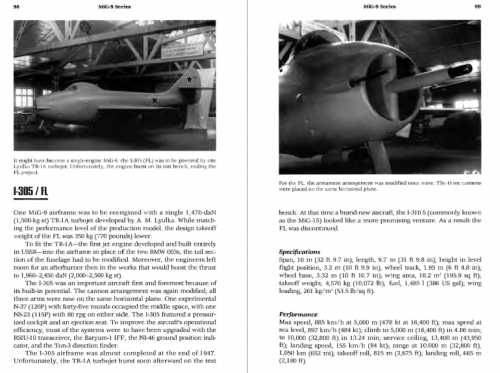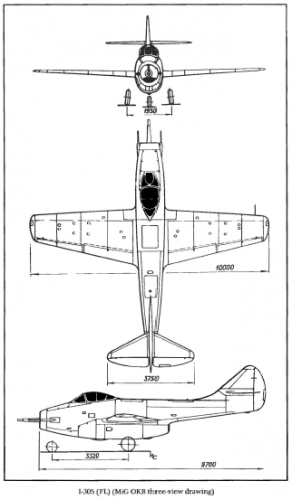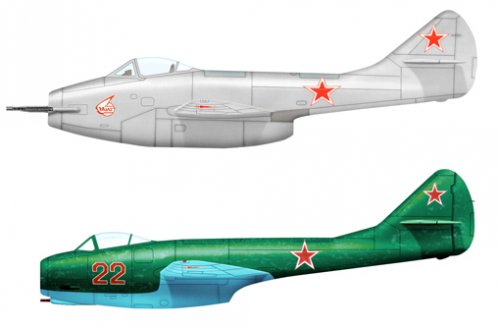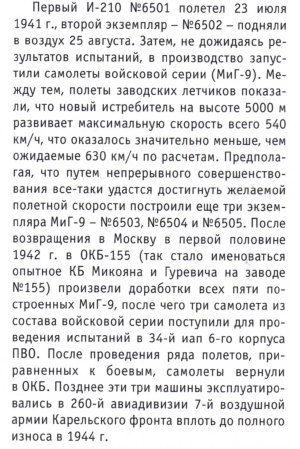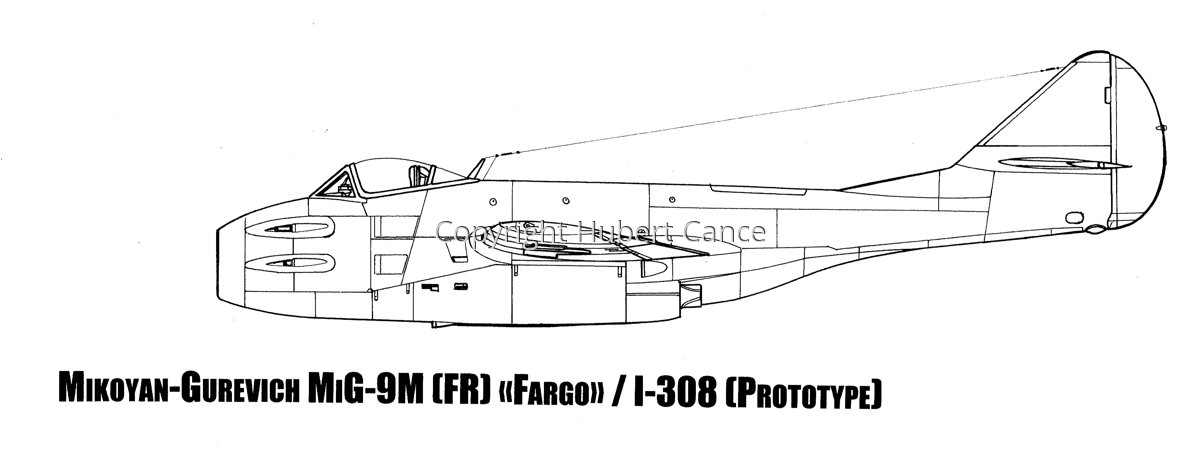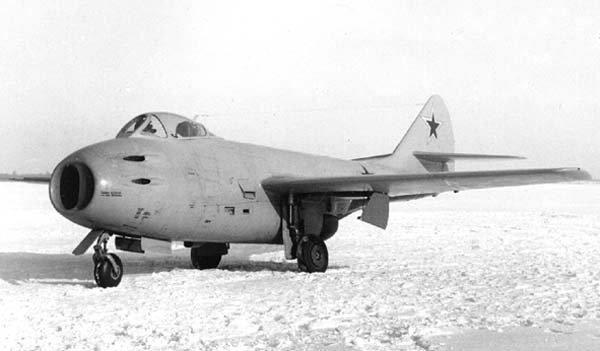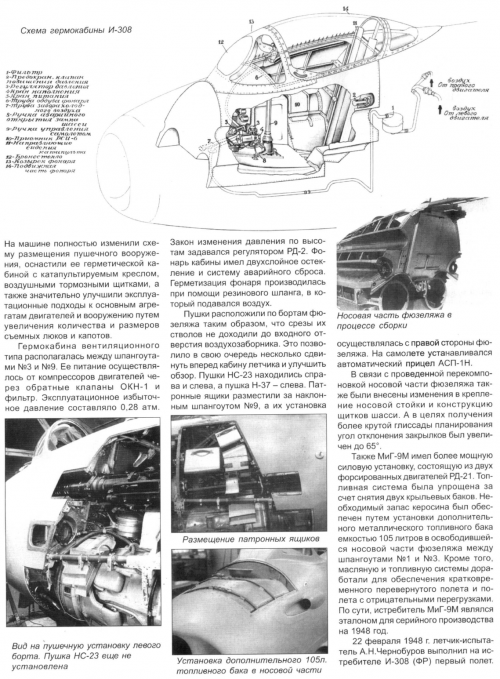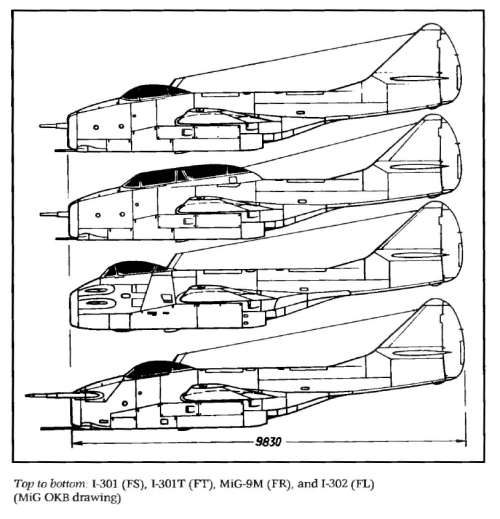You are using an out of date browser. It may not display this or other websites correctly.
You should upgrade or use an alternative browser.
You should upgrade or use an alternative browser.
MiG-9 Projects and Prototypes
- Thread starter Zizi6785
- Start date
- Joined
- 26 May 2006
- Messages
- 34,894
- Reaction score
- 15,759
hesham said:Until remember the source,
The MiG I-210 was also given the designation MiG-9 ?.
I get it,it's Kryl'ya 2008.
Attachments
Last edited by a moderator:
- Joined
- 27 December 2005
- Messages
- 17,748
- Reaction score
- 26,407
MiG - Flying Through Time (no drawing, sadly).The MiG-9M (I-308, FR) aircraft most fully met the Air Force requirements, equipped with a pressurized cabin, ejection seat, brake flaps, improved operational approaches to the RD-21 engine units and weapons. Its three cannons were located on the sides of the fuselage, so that the muzzle cuts did not reach the air intake. Test pilot A. N. Chernoburov performed the first flight on the I-308 on February 22, 1948. Flight tests showed that the speed increase compared to the serial MiG-9 was 55 km/h, and the time to climb to 5000 m was reduced by 1 minute 36 seconds. Firing tests conducted at an altitude of 11,500 m proved that the new gun placement generally improved the operation of the power plant during salvo firing and the engines did not stall. In May, the aircraft was transferred to the State Research Institute of the Air Force for state testing. However, the I-308 did not pass the main test, since this version of the MiG-9 did not meet the 1948 level, when the MiG-15 was already being tested.
- Joined
- 27 December 2005
- Messages
- 17,748
- Reaction score
- 26,407
Evgeniy Arsenyev - Aviatsiya i Kosmonautika 2003 01MiG-9M (I-308, FR)
MiG-9 with uprated RD-21 engines The MiG-9M fighter, which also received the factory designation I-308 and the code name “FR”, was built in late 1947 in accordance with the requirements of the Air Force. Its design reflected all the military requirements for improving the flight and technical and operational characteristics of the MiGG-9 aircraft. The machine completely changed the layout of the gun armament, equipped it with a pressurized cabin with an ejection seat, air brake flaps, and significantly improved operational approaches to the main engine units and armament by increasing the number and size of removable hatches and cowlings.
The pressurized cabin of the ventilation type was located between frames No. 3 and No. 9. It was fed from the engine compressors through OKN-1 check valves and a filter. The operating excess pressure was 0.28 atm. The pressure change law for altitudes was set by the RD-2 regulator. The cockpit canopy had double-layer glazing and an emergency release system. The canopy was sealed with a rubber hose into which air was supplied.
The canopies were positioned along the sides of the fuselage in such a way that the cuts of their barrels did not reach the air intake inlet. This, in turn, allowed the pilot's cabin to be moved forward somewhat and visibility to be improved. The NS-23 cannons were located on the right and left, and the N-37 cannon was on the left. The ammunition boxes were placed behind inclined frame No. 9, and their installation and Installation of an additional 105l. fuel tank in the nose section The nose section of the fuselage was assembled from the right side of the fuselage during the assembly process. The ASP-1N automatic sight was installed on the aircraft.
In connection with the rearrangement of the nose section of the fuselage, changes were also made to the fastening of the nose strut and the design of the landing gear flaps. And in order to obtain a steeper glide path, the flap deflection angle was increased to 65°. The MiG-9M also had a more powerful power plant, consisting of two uprated RD-21 engines. The fuel system was simplified by removing two wing tanks. The required supply of kerosene was provided by installing an additional metal fuel tank with a capacity of 105 liters in the freed nose section of the fuselage between frames No. 1 and No. 3. In addition, the oil and fuel systems were modified to ensure short-term inverted flight and flight with negative overloads.
In essence, the MiG-9M fighter was the standard for serial production in 1948. On February 22, 1948, test pilot A. N. Chernoburov performed the first flight on the I-308 (FR) fighter. Flight tests showed that the I-308 aircraft had a 55 km/h increase in speed compared to the serial MiG-9. Firing tests conducted at an altitude of 11,500 m showed that, in general, the new placement of the guns improved the operation of the power plant during salvo firing. In the second half of March, the cartridge and link diverters were redesigned to prevent spent cartridges and links from hitting the wing and stabilizer of the aircraft. Factory tests of the "FR" aircraft were completed on April 26, 1948.
On May 6, test pilot of the State Research Institute of the Air Force D.G.Pikulenko performed a test flight of the I-308 fighter, and then the aircraft was transferred to state tests. However, the I-308 did not pass the main test, and on August 31, V.N.Yuganov flew the "FR" aircraft back. By this time, the MiG-9EM fighter was morally obsolete, since tests of the experimental prototypes of the MiG-15 fighter (I-310, S) were already in full swing. In addition, there were no prospects for launching the I-308 aircraft into series production for the same reasons as the I-307.
Main characteristics of the I-308 (FR) fighter
Aircraft length, m - 9.83
Wingspan, m - 10.0
Wing area, sq m - 18.2
Aircraft altitude in the flight line, m - 3.225
Takeoff weight, kg - 5140
Fuel reserve, kg - 1300
Maximum flight speed, km/h:
near the ground - 872
at an altitude of 5000 m - 965
Time to climb to altitude
5000 m, min - 3.5
Practical ceiling, m - 14000
Practical flight range, km:
at an altitude of 5000 m - 830
Length of takeoff run, m - 830
Length of landing run, m - 920
Landing speed, km/h - 166
Attachments
- Joined
- 27 December 2005
- Messages
- 17,748
- Reaction score
- 26,407
There doesn't seem to be any books just on the MiG-9, and it doesn't seem to get much attention as it was very much overshadowed by the MiG-15.


